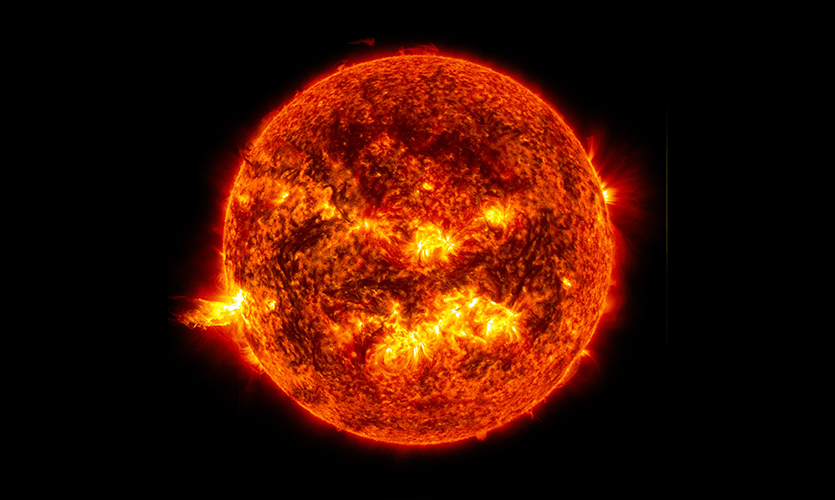The Problem
Since first observing the sun’s magnetic activity, astronomers have struggled to pinpoint where the process originates.
Since first observing the sun’s magnetic activity, astronomers have struggled to pinpoint where the process originates.
A new model that posits the same physical process is responsible for magnetic field and the rotation patterns, contradicting previous theories that the sun’s magnetic field originates deep inside its interior.
The findings could improve prediction systems for forecasting solar storms, which Earth experienced earlier this month.
Professor Daniel Lecoanet, Postdoctoral Researcher Kyle Augustson
An international team of researchers including Northwestern Engineering’s Daniel Lecoanet is getting closer to solving a 400-year-old solar mystery that stumped even famed astronomer Galileo Galilei.

Since first observing the sun’s magnetic activity, astronomers have struggled to pinpoint where the process originates. Now, after running a series of complex calculations on a NASA supercomputer, the researchers discovered the magnetic field is generated about 20,000 miles below the sun’s surface.
The finding contradicts previous theories, which suggest the phenomenon has deep origins — beginning more than 130,000 miles below the sun’s surface.
The research was published May 22 in the journal Nature.
Not only does the new discovery help us better understand our sun’s dynamic processes, it also could help scientists more accurately forecast powerful solar storms. Although this month’s strong solar storms released beautiful, extended views of the Northern Lights, similar storms can cause intense destruction — damaging Earth-orbiting satellites, electricity grids, and radio communications.
“Understanding the origin of the sun’s magnetic field has been an open question since Galileo and is important for predicting future solar activity, like flares that could hit the Earth,” study co-author Lecoanet said. “This work proposes a new hypothesis for how the sun’s magnetic field is generated that better matches solar observations, and, we hope, could be used to make better predictions of solar activity.”
Daniel LecoanetAssistant Professor of Engineering Sciences and Applied Mathematics
An expert in astrophysical fluid dynamics, Lecoanet is an assistant professor of engineering sciences and applied mathematics at the McCormick School of Engineering and a member of the Center for Interdisciplinary Exploration and Research in Astrophysics. Geoffrey Vasil, a mathematics professor at the University of Edinburgh in Scotland, led the study.
For centuries, astronomers have studied the tell-tale signs of the sun’s magnetic activity. Among them was Galileo, who made the first detailed observations of sunspots in 1612. Using early telescopes and even his naked-eye, Galileo documented the shifting dark patches caused by the sun’s ever-changing magnetic field.
Over the years, astronomers have made significant progress in understanding the origins of the solar dynamo — the physical process that generates the magnetic field — but limitations have remained. Theories suggesting the dynamo has a deep origin, for example, predict solar features that astronomers have never observed, such as strong magnetic fields at high latitudes.
To solve this puzzle, the research team developed new, state-of-the-art numerical simulations to model the sun’s magnetic field. Unlike previous models, the new model accounts for torsional oscillations, a cyclical pattern of how gas and plasma flow within and around the sun. Because the sun is not solid like the Earth and moon, it doesn’t rotate as one body. Instead, its rotation varies with latitude. Like the 11-year solar magnetic cycle, torsional oscillations also experience an 11-year cycle.

“Because the wave has the same period as the magnetic cycle, it has been thought that these phenomena were linked,” Lecoanet said. “However, the traditional ‘deep theory’ of the solar magnetic field does not explain where these torsional oscillations come from. An intriguing clue is that the torsional oscillations are only near the surface of the sun. Our hypothesis is that the magnetic cycle and the torsional oscillations are different manifestations of the same physical process.”
When Kyle Augustson, a postdoctoral fellow in Lecoanet’s lab at Northwestern, ran the numerical simulations, the researchers found their new model provided a quantitative explanation for properties observed in the torsional oscillations. The model also explains how sunspots follow patterns of the sun’s magnetic activity — another detail missing from the deep origin theory.
With a better understanding of the sun’s dynamo, researchers hope to improve forecasts for solar storms. When solar flares and coronal mass ejections launch toward Earth, they can severely damage electrical and telecommunications infrastructure, including GPS navigation tools. This month’s recent solar storms, for example, knocked out navigational systems for farming equipment — right at peak planting season.
But the researchers look to an even more powerful solar storm that hit Canada in September 1859 as a cautionary tale. Dubbed the Carrington Event, the intense storm damaged the country’s fledgling telegraph system. With enough warning, engineers could take steps to prevent catastrophic damage in the future.
“While the recent solar storms were powerful, we’re worried about even more powerful storms like the Carrington Event,” Lecoanet said. “If a storm of similar intensity hit the United States today, it would cause an estimated $1 trillion to $2 trillion in damage. Although many aspects of solar dynamics remain shrouded in mystery, our work makes huge strides in cracking one of the oldest unsolved problems in theoretical physics and opens the way to better predictions of dangerous solar activity.”